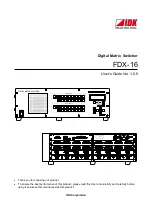
32
Web User Guide
Quick Starting the Networking Device
NOTE:
Before you use the information in this section, ensure that you have upgraded to the
latest firmware. See “Upgrading the Switch Firmware” on page 31.
1.
Read “Installing the Hardware” on page 19 for the connectivity procedure. In-band connectivity
allows access to the D-Link software locally or from a remote workstation. You must configure the
device with IP information (IP address, subnet mask, and default gateway).
2.
Turn the Power ON.
3.
Allow the device to load the software until the login prompt appears. The device initial state is
called the default mode.
4.
When the prompt asks for operator login, do the following steps:
Type
admin
at the login prompt. Since a number of the Quick Setup commands
require administrator account rights, D-Link suggests logging into an administrator
account.
Do not enter a password because the default mode does not use a password.
The CLI User EXEC prompt is displayed.
Enter
enable
to switch to the Privileged EXEC mode from User EXEC.
Enter
configure
to switch to the Global Config mode from Privileged EXEC.
Enter
exit
to return to the previous mode.
Enter
?
to show a list of commands that are available in the current mode.
System Information and System Setup
This section describes the commands you use to view system information and to setup the
network device. Table 5 contains the Quick Start commands that allow you to view or
configure the following information:
z
Software versions
z
Physical port data
z
User account management
z
IP address configuration
z
Uploading from Networking Device to Out-of-Band PC (Only XMODEM)
z
Downloading from Out-of-Band PC to Networking Device (Only XMODEM)
z
Downloading from TFTP Server
z
Restoring factory defaults
If you configure any network parameters, you should execute the following command:
copy system:running-config nvram:startup-config
This command saves the changes to the configuration file. You must be in the correct mode to
execute the command. If you do not save the configuration, all changes are lost when a you
power down or reset the networking device.
Summary of Contents for DES-3226L
Page 2: ......
Page 6: ...6 Web User Guide...
Page 8: ...8 Web User Guide...
Page 30: ...30 Web User Guide...
Page 36: ...36 Web User Guide...
Page 44: ...44 Web User Guide...
Page 52: ...52 Web User Guide Figure 15 System Port Multiple Port Mirroring...
Page 58: ...58 Web User Guide...
Page 70: ...70 Web User Guide...
Page 75: ...Registration 75 Registration...
Page 76: ...76 Web User Guide...
Page 77: ...Technical Support 77 Technical Support...
Page 78: ...78 Web User Guide...
Page 79: ...Technical Support 79...
Page 80: ...80 Web User Guide...
Page 81: ...Technical Support 81...
Page 82: ...82 Web User Guide...
Page 83: ...Technical Support 83...
Page 84: ...84 Web User Guide...
Page 85: ...Technical Support 85...
Page 86: ...86 Web User Guide...
Page 87: ...Technical Support 87...
Page 88: ...88 Web User Guide...
Page 89: ...Technical Support 89...
Page 90: ...90 Web User Guide...
Page 91: ...Technical Support 91...
Page 92: ...92 Web User Guide...
Page 93: ...Technical Support 93...
Page 94: ...94 Web User Guide...
Page 95: ...Technical Support 95...
Page 96: ...96 Web User Guide...
Page 97: ...Technical Support 97...
Page 98: ...98 Web User Guide...
Page 99: ...Technical Support 99...
Page 100: ...100 Web User Guide...
Page 101: ...Technical Support 101...
Page 102: ...102 Web User Guide...
Page 104: ...104 Web User Guide...
Page 106: ...A 2 Web User Guide...
Page 108: ...B 2 Web User Guide...
Page 110: ...C 2 Web User Guide...
















































